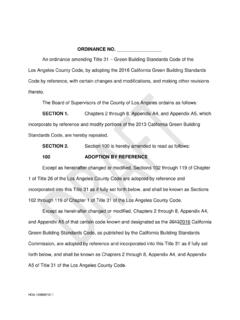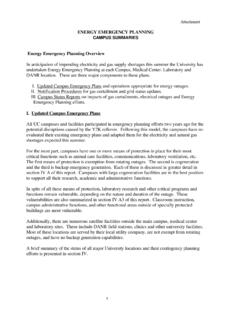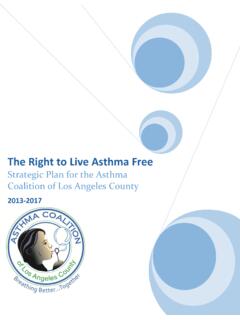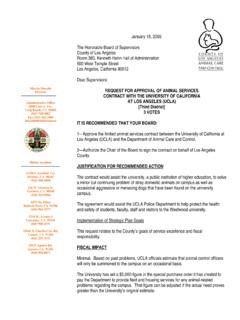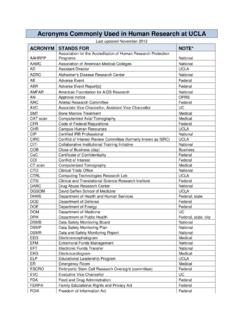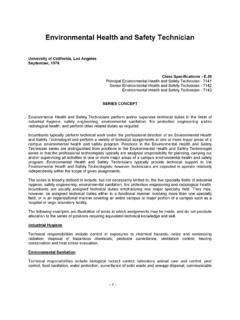Transcription of 4.E. Greenhouse Gas Emissions - Los Angeles County ...
1 ENVIRONMENTAL IMPACT ANALYSIS E. Greenhouse GAS Emissions 1. INTRODUCTION This section addresses Greenhouse gas (GHG) Emissions generated by the construction and operation of the Project inclusive of mandatory and voluntary energy and resource conservation measures that have been incorporated into the Project to reduce GHG Emissions and associated impacts. The analysis also addresses the consistency of the Project with applicable regulations, plans, and policies set forth by the State of California and the County to reduce GHGs. The Project's potential contributions to global climate change impacts are identified. GHG emission calculations prepared for the Project are provided in Appendix D of this Draft EIR.
2 2. ENVIRONMENTAL SETTING Global climate change refers to changes in average climatic conditions on Earth as a whole, including changes in temperature, wind patterns, precipitation and storms. Historical records indicate that global climate changes have occurred in the past due to natural phenomena; however current data increasingly indicate that the current global conditions differ from past climate changes in rate and magnitude. Global climate change attributable to anthropogenic (human) GHG Emissions is currently one of the most important and widely debated scientific, economic and political issues in the United States and the world. The extent to which increased concentrations of GHGs have caused or will cause climate change and the appropriate actions to limit and/or respond to climate change are the subject of significant and rapidly evolving regulatory efforts at the federal and state levels of government.
3 GHGs are those compounds in the Earth's atmosphere which play a critical role in determining temperature near the Earth's surface. More specifically, these gases allow high frequency shortwave solar radiation to enter the Earth's atmosphere, but retain some of the low frequency infrared energy which is radiated back from the Earth towards space, resulting in a warming of the atmosphere. Not all GHGs possess the same ability to induce climate change; as a result, GHG contributions are commonly quantified in the units of equivalent mass of carbon dioxide (CO2e). Mass Emissions are calculated by converting pollutant specific Emissions to CO2e Emissions by applying the proper global warming potential (GWP) These GWP ratios are available from the Intergovernmental Panel on Climate Change (IPCC).
4 Historically, GHG emission inventories have been calculated using the GWPs from the IPCC's Second Assessment Report (SAR). The IPCC updated the GWP values based on the latest science in its Fourth Assessment Report (AR4). The updated GWPs in the IPCC AR4 have begun to be used in recent GHG Emissions inventories; however, the resulting difference in CO2e Emissions is relatively minor. By applying the GWP ratios, project related CO2e Emissions can be tabulated in metric tons per year. Typically, the GWP ratio corresponding to the warming potential of CO2 over a 100 year period is used as a baseline. The CO2e values are calculated for construction years as well as Existing Hospital and Master plan Project buildout conditions in order to generate a net change in GHG Emissions for construction and operation.
5 Compounds that are regulated as GHGs are discussed below. 1. GWPs and associated CO2e values were developed by the Intergovernmental Panel on Climate Change. Los Angeles County department of public Works Harbor UCLA Medical Center Campus Master plan Project SCH# 2014111004 1. Greenhouse Gas Emissions August 2016 Carbon Dioxide (CO2): CO2 is the most abundant GHG in the atmosphere and is primarily generated from fossil fuel combustion from stationary and mobile sources. CO2 is the reference gas (GWP of 1) for determining the GWPs of other GHGs. Methane (CH4): CH4 is emitted from biogenic sources ( , resulting from the activity of living organisms), incomplete combustion in forest fires, landfills, manure management, and leaks in natural gas pipelines.
6 The GWP of CH4 is 21 in the IPCC SAR and 25 in the IPCC AR4. Nitrous Oxide (N2O): N2O produced by human related sources including agricultural soil management, animal manure management, sewage treatment, mobile and stationary combustion of fossil fuel, adipic acid production, and nitric acid production. The GWP of N2O is 310 in the IPCC SAR and 298 in the IPCC AR4. Hydrofluorocarbons (HFCs): HFCs are fluorinated compounds consisting of hydrogen, carbon, and fluorine. They are typically used as refrigerants in both stationary refrigeration and mobile air conditioning systems. The GWPs of HFCs ranges from 140 for HFC 152a to 11,700 for HFC 23 in the IPCC SAR and 124 for HFC 152a to 14,800 for HFC 23 in the IPCC AR4.
7 Perfluorocarbons (PFCs): PFCs are fluorinated compounds consisting of carbon and fluorine. They are primarily created as a byproduct of aluminum production and semiconductor manufacturing. The GWPs of PFCs range from 6,500 to 9,200 in the IPCC SAR and 7,390 to 17,700 in the IPCC AR4. Sulfur Hexafluoride (SF6): SF6 is a fluorinated compound consisting of sulfur and fluoride. It is a colorless, odorless, nontoxic, nonflammable gas. It is most commonly used as an electrical insulator in high voltage equipment that transmits and distributes electricity. SF6 has a GWP of 23,900 in the IPCC SAR and 22,800 in the IPCC AR4. a. Existing Conditions (1) Greenhouse Gas Emissions Inventory Worldwide man made Emissions of GHGs were approximately 49,000 million metric tons (MMT) CO2e annually including ongoing Emissions from industrial and agricultural sources and Emissions from land use changes ( , deforestation).
8 2 Emissions of CO2 from fossil fuel use and industrial processes accounts for 65 percent of the total while CO2 Emissions from all sources accounts for 76 percent of the total. Methane Emissions account for 16 percent and N2O Emissions for percent. In 2013, the United States was the world's second largest emitter of carbon dioxide at 5,300 MMT (China was the largest emitter of carbon dioxide at 10,300 MMT).3 The California Air Resources Board (CARB) compiles GHG inventories for the State of California. Based on the 2013 GHG inventory data ( , the latest year for which data are available from CARB), California emitted MMTCO2e including Emissions resulting from imported electrical power and MMTCO2e 2. Intergovernmental Panel on Climate Change, Fifth Assessment Report Synthesis Report, 2014.
9 3. PBL Netherlands Environmental Assessment Agency and the European Commission Joint Research Center, Trends in Global CO2 Emissions 2014 Report, 2014. Los Angeles County department of public Works Harbor UCLA Medical Center Campus Master plan Project SCH# 2014111004 2. August 2016 Greenhouse Gas Emissions excluding Emissions related to imported Between 1990 and 2013, the population of California grew by approximately million (from to million).5 This represents an increase of approximately percent from 1990 population levels. In addition, the California economy, measured as gross state product, grew from $773 billion in 1990 to $ trillion in 2013 representing an increase of approximately 186 Despite the population and economic growth, California's net GHG Emissions only grew by approximately percent between 1990 and 2013.
10 The California Energy Commission (CEC) attributes the slow rate of growth to the success of California's renewable energy programs and its commitment to clean air and clean Table 1, State of California Greenhouse Gas Emissions , identifies and quantifies statewide anthropogenic GHG Emissions and sinks ( , carbon sequestration due to forest growth) in 1990 and 2011 ( , the most recent year in which data are available from CARB). As shown in the table, the transportation sector is the largest contributor to statewide GHG Emissions at 37 percent in 2013. (2) Existing Site Greenhouse Gas Emissions The Medical Center Campus is currently developed with approximately million square feet of differentiated buildings including the hospital and the current hospital expansion in the east sector of the Medical Center Campus; LA Biomed facilities in the central portion of the Medical Center Campus; administration and facilities management buildings in various locations of the Medical Center Campus; and large tenants, such as the Children's Institute International and MFI's Harbor UCLA Professional Building (outpatient care) and Imaging Center, in the west sector of the Medical Center Campus.









